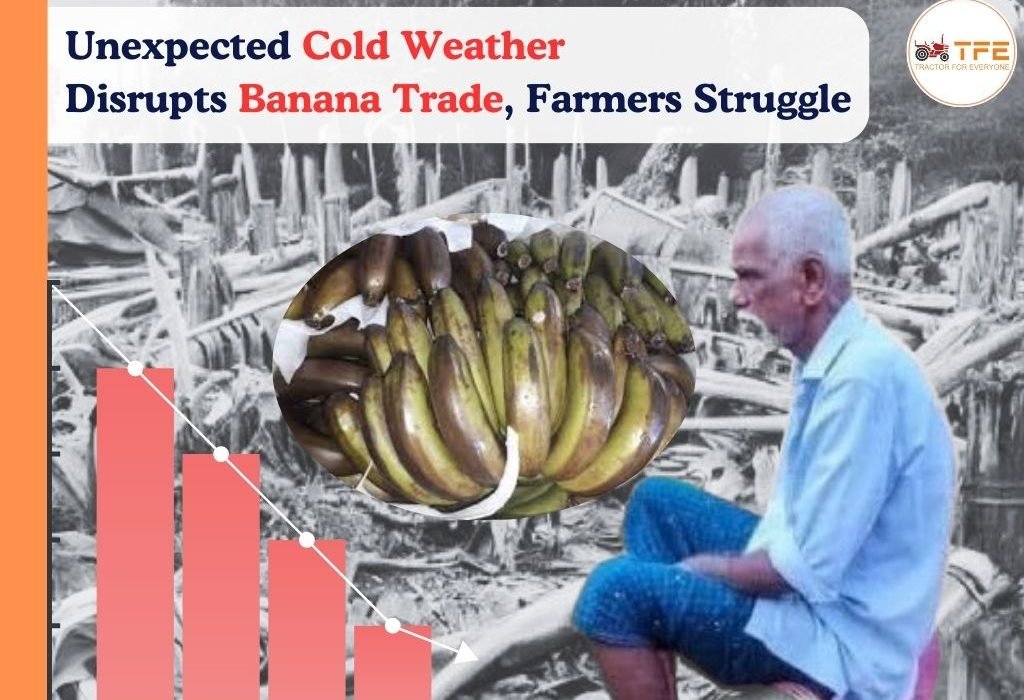Unexpected Cold Weather Disrupts India’s Banana Trade, Farmers Struggle to Recover

A sudden and severe cold snap across India has dealt a major blow to the banana export industry, leading to a 30% decline in exports and an estimated loss of ₹200 crore. Farmers and traders are struggling as crop damage affects fruit quality, making bananas unsuitable for international markets. The oversupply in local markets has further pushed down prices, leaving farmers in financial distress.
Impact of Cold Weather on Banana Exports
India, one of the world’s largest banana producers, relies heavily on exports to sustain millions of farmers. However, the unexpected drop in temperatures has significantly affected banana production. The cold weather has stunted growth and reduced the fruit’s size, color, and ripening process, making it difficult to meet the stringent quality standards required for exports.
Major banana-producing states like Maharashtra, Andhra Pradesh, Tamil Nadu, and Uttar Pradesh have reported a drastic decline in yield due to frost and prolonged low temperatures. With a significant portion of export-quality bananas rendered unsuitable for shipment, the industry faces a major setback.
Economic Consequences for Farmers
The financial impact on farmers has been devastating. Bananas are a primary source of income for many small and medium-scale farmers in rural areas. The decline in exports has resulted in an oversupply in local markets, forcing farmers to sell their produce at significantly lower prices. In some cases, the revenue from sales is not even enough to cover production costs, leading to heavy income losses.
Without alternative crops to rely on, affected farmers find themselves in an increasingly difficult financial situation. The lack of adequate cold storage facilities exacerbates the problem, causing additional spoilage and loss. Although the Indian government has acknowledged the crisis and is considering financial aid programs, many farmers believe that the assistance provided so far is insufficient to compensate for the losses, which are estimated to be around ₹200 crore.
Challenges in Meeting Export Goals
India’s horticulture sector had set ambitious goals for banana exports, targeting a 20% growth in the next fiscal year. However, the recent cold snap threatens these targets. Experts warn that unless weather conditions stabilize and infrastructure improves, India’s ability to expand its banana exports will remain uncertain.
Beyond weather conditions, logistical challenges such as inadequate cold storage and transportation facilities continue to hinder the banana trade. Given the perishable nature of bananas, maintaining quality during transit is critical. The lack of reliable storage options makes it difficult for farmers to preserve their produce, further affecting export potential.
Market Opportunities Amidst Challenges
Despite the challenges, new market opportunities are emerging. Indian exporters are exploring potential in Russia and Europe, where banana demand has been steadily increasing. Expanding into these markets could help mitigate financial losses caused by disruptions in traditional markets in the Middle East and Southeast Asia.
Additionally, there is growing interest in diversifying banana products. Value-added products such as banana chips, banana flour, and even banana wine are gaining popularity both domestically and internationally. By investing in processing facilities, farmers can create alternative revenue streams and reduce dependence on fresh banana exports.
Innovation and Adaptation for Future Sustainability
The long-term sustainability of India’s banana export industry depends on innovation and adaptation. Climate change remains a persistent threat, making it essential to develop resilient banana varieties that can withstand temperature fluctuations and extreme weather conditions.
Research into hardier banana strains and improved farming techniques, such as drip irrigation, mulching, and agroforestry, can help reduce climate-related risks. Enhancing infrastructure, particularly in cold storage and transportation, will also be crucial. Providing farmers with access to refrigerated transport and pack-houses can significantly reduce post-harvest losses and ensure better quality for exports.
Conclusion
The recent cold wave has severely impacted India’s banana trade, causing significant losses for farmers and exporters. While immediate financial hardship is unavoidable, opportunities for recovery exist through market diversification, agricultural innovation, and infrastructure development. To remain a global leader in banana exports, India must adapt to climate challenges and enhance its logistical capabilities. Collaboration between the government, private sector, and farmers will be essential to securing the future of India’s banana industry.
FAQs
How much have banana exports declined due to the cold snap?
The cold weather has caused a 30% decline in banana exports, leading to an estimated ₹200 crore loss.
What are the financial consequences for farmers?
Farmers are struggling with income losses due to oversupply in local markets and lower prices, often failing to recover production costs.
How is the government supporting affected farmers?
The Indian government is discussing financial aid programs, but many farmers feel the assistance is insufficient to cover their losses.
Are there new markets for Indian banana exports?
Yes, exporters are exploring opportunities in Russia and Europe, where banana demand is increasing.
What strategies can improve banana production and exports?
Developing resilient banana varieties, improving cold storage and transport infrastructure, and investing in value-added products like banana chips and flour can enhance sustainability and profitability.